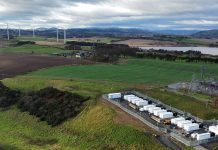Scotland’s gravity battery pioneers Gravitricity believe the recent grid connection of their pilot plant in Edinburgh’s port will give a new meaning to the words ‘power drop’.
Sunshine won’t be needed on Leith, the energy innovators believe, just notably more dependable planetary attraction, if successes already proven by the start-up’s trial rig can be replicated at utility scale.
The firm says tests now prove that dropping massive weights to generate electricity can achieve the kind of near-instant response required for grid operation. Revenues from frequency response (FR) services from DNOs could then flow from Gravitricity’s technology.
On Gravitricity’s existing 12 metre, £1million test tower in Leith, the firm have generated 250 kWh from lowering two 25 tonne weights in combination.
Derrick and live
The deeper the drop, the more carbon-free electricity can be cycled. Gravitricity aims to expand their technology into disused mineshafts worldwide or possibly bigger purpose-built rigs. Deployments of up to 8MWh are realistic possibilities, managing director Charlie Blair believes.
In South Africa the firm is talking to extractor United Mining Services about possible shafts. Talks with Polish, Czech, Scandinavian and British miners are also under way.
Based on ‘positional’ latency and not on chemistry, gravity-based energy storage avoids a sourcing problem increasingly linked to conventional batteries. Rare minerals used in battery such as cobalt, nickel and lithium are in some cases getting rarer. Mining them in remote, sometimes unstable jurisdictions can invite interruptions to supply, as well as reputational risk.
Gravity-based batteries can last up to 25 years, with no drop-off in power achieved, the Scots firm notes.
Tech incubation fund Innovate UK is backing Gravitricity. Dutch engineers Huisman supply its winches.
Charlie Blair commented, “[Gravitricity] has proven we can go from zero to full power in less than a second – which can be extremely valuable in the frequency response and back-up power markets”.
The technology’s potential to vary output, reflecting minute-by-minute changes in market power demand, is a further advantage, Blair noted.




Kellingley Colliery in the UK is a kilometre deep.
With a weight of 3000 tonnes that would give a storage capacity of around 8 MWh.
I can remember being told by an engineer that 4000 tonne lifts were possible in the 1970s.
If that was correct, the capacity of several MWh is possible.
How much electricity is used to bring 50 tonnes back up?
info@gravitricity.com is the email address whereby you may satisfy your curiosity, Sir, or 0131 554 6966 is your number to call. Why not share your findings further with The Energyst’s community of readers here? https://gravitricity.com/about-gravitricity/ was put up for a reason. Regards, AT